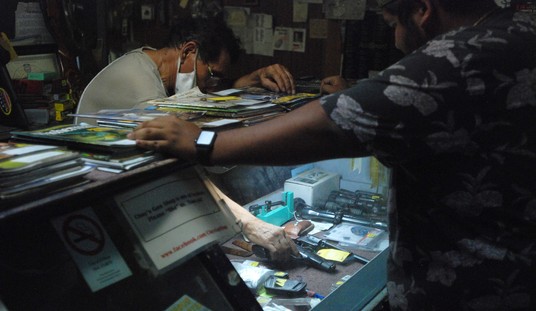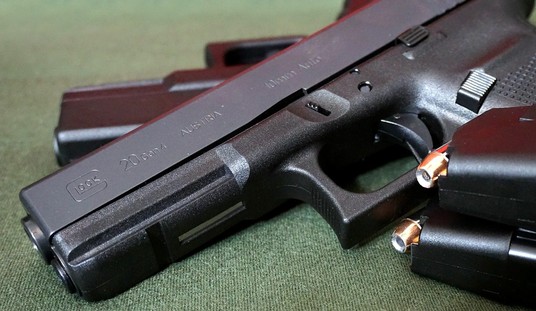We hear it constantly from droning citizen control cultists.
The argument goes something like this.
“You want to listen to the last part of the Second Amendment where is says ‘shall not be infringed,’ but you ignore the part where it says you have to be a ‘well-regulated militia.'”
Invariably, they argue that “well-regulated” means “subject to extensive government regulations.”
But what does “well-regulated really mean?
Constitution.org argues:
The following are taken from the Oxford English Dictionary, and bracket in time the writing of the 2nd amendment:
1709: “If a liberal Education has formed in us well-regulated Appetites and worthy Inclinations.”
1714: “The practice of all well-regulated courts of justice in the world.”
1812: “The equation of time … is the adjustment of the difference of time as shown by a well-regulated clock and a true sun dial.”
1848: “A remissness for which I am sure every well-regulated person will blame the Mayor.”
1862: “It appeared to her well-regulated mind, like a clandestine proceeding.”
1894: “The newspaper, a never wanting adjunct to every well-regulated American embryo city.”
The phrase “well-regulated” was in common use long before 1789, and remained so for a century thereafter. It referred to the property of something being in proper working order. Something that was well-regulated was calibrated correctly, functioning as expected. Establishing government oversight of the people’s arms was not only not the intent in using the phrase in the 2nd amendment, it was precisely to render the government powerless to do so that the founders wrote it.
Daniel J. Schultz further expounds upon the meaning well-regulated at the time the Second Amendment was written, and in the context of the rest of the Constitution. Settle in and really read this, and make sure that you grasp the full weight and meaning.
We begin this analysis by examining how the term “regulate” was used elsewhere in the Constitution. In every other instance where the term “regulate” is used, or regulations are referred to, the Constitution specifies who is to do the regulating and what is being “regulated.” However, in the Second Amendment, the Framers chose only to use the term “well regulated” to describe a militia and chose not to define who or what would regulate it.
It is also important to note that the Framers’ chose to use the indefinite article “a” to refer to the militia, rather than the definite article “the.” This choice suggests that the Framers were not referring to any particular well regulated militia but, instead, only to the concept that well regulated militias, made up of citizens bearing arms, were necessary to secure a free State. Thus, the Framers chose not to explicitly define who, or what, would regulate the militias, nor what such regulation would consist of, nor how the regulation was to be accomplished.
This comparison of the Framers’ use of the term “well regulated” in the Second Amendment, and the words “regulate” and “regulation” elsewhere in the Constitution, clarifies the meaning of that term in reference to its object, namely, the Militia. There is no doubt the Framers understood that the term “militia” had multiple meanings. First, the Framers understood all of the people to be part of the unorganized militia. The unorganized militia members, “the people,” had the right to keep and bear arms. They could, individually, or in concert, “well regulate” themselves; that is, they could train to shoot accurately and to learn the basics of military tactics.
This interpretation is in keeping with English usage of the time, which included within the meaning of the verb “regulate” the concept of self- regulation or self-control (as it does still to this day). The concept that the people retained the right to self-regulate their local militia groups (or regulate themselves as individual militia members) is entirely consistent with the Framers’ use of the indefinite article “a” in the phrase “A well regulated Militia.”
This concept of the people’s self-regulation, that is, non-governmental regulation, is also in keeping with the limited grant of power to Congress “for calling forth” the militia for only certain, limited purposes, to “provide for” the militia only certain limited control and equipment, and the limited grant of power to the President regarding the militia, who only serves as Commander in Chief of that portion of the militia called into the actual service of the nation. The “well regula[tion]” of the militia set forth in the Second Amendment was apart from that control over the militia exercised by Congress and the President, which extended only to that part of the militia called into actual service of the Union. Thus, “well regula[tion]” referred to something else. Since the fundamental purpose of the militia was to serve as a check upon a standing army, it would seem the words “well regulated” referred to the necessity that the armed citizens making up the militia(s) have the level of equipment and training necessary to be an effective and formidable check upon the national government’s standing army.
It is quite clear that the Founders used the phrase “well-regulated” to denote that militia forces should be skilled with arms of contemporary military utility and relevant military tactics, so that they can serve in the defense of Republic against both foreign invaders and the threat of domestic tyrants commanding a national army against the liberty of the citizenry.
While few of us like to think in these terms, the Founders were adamant that the citizens retain not just weapons of contemporary utility, but the ability to use these weapons effectively in defense of the nation from both internal and external threats. Put another way, the right of the people to keep and bear arms is conjoined with the responsibility to use those arms effectively, and the Founders wanted us to be able to serve in militias… which they studiously avoided defining, as Mr. Schultz noted above.

“Well-regulated militia” may therefore apply to individual riflemen who have drilled to be competent with firearms of contemporary military utility, such as many of today’s most popular semi-automatic magazine-fed rifles with their standard-capacity magazines. It can also apply to more advanced groups learning the small unit tactics that are the building block of modern infantry units, or most kinds of shooting sports competitions.
While it likely terrifies those in our bloated and increasingly despotic government, shooting schools are teaching both individual firearms courses and small unit tactics to teams of shooters to the tune of hundreds of thousands of citizens a year. No matter their specialized focus, and whether they focus on general marksmanship skills or tactical skills of a more obvious military focus, these are all efforts to ensure that the modern militia—We, the People—are indeed “well-regulated” as the Founders intended.








Join the conversation as a VIP Member